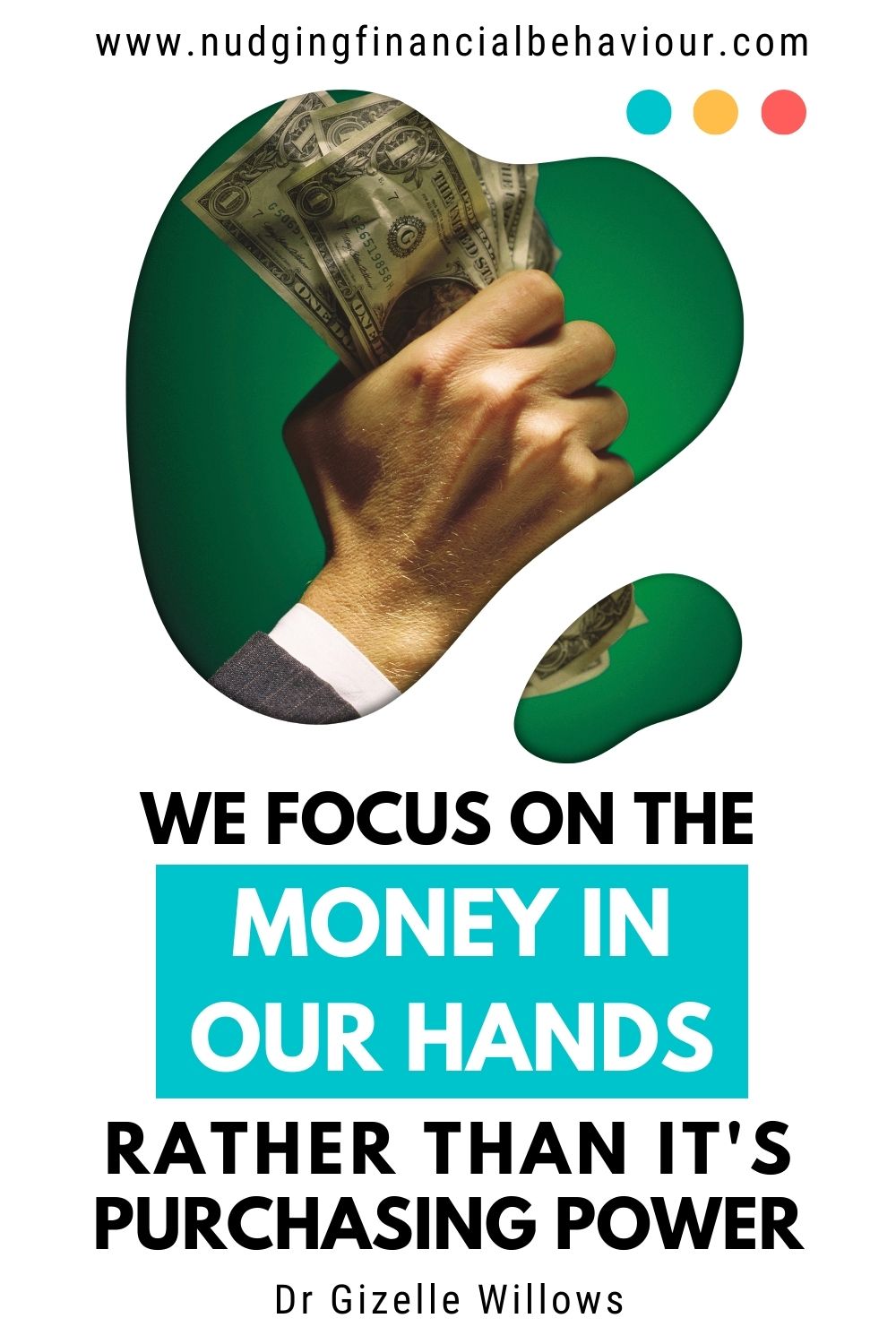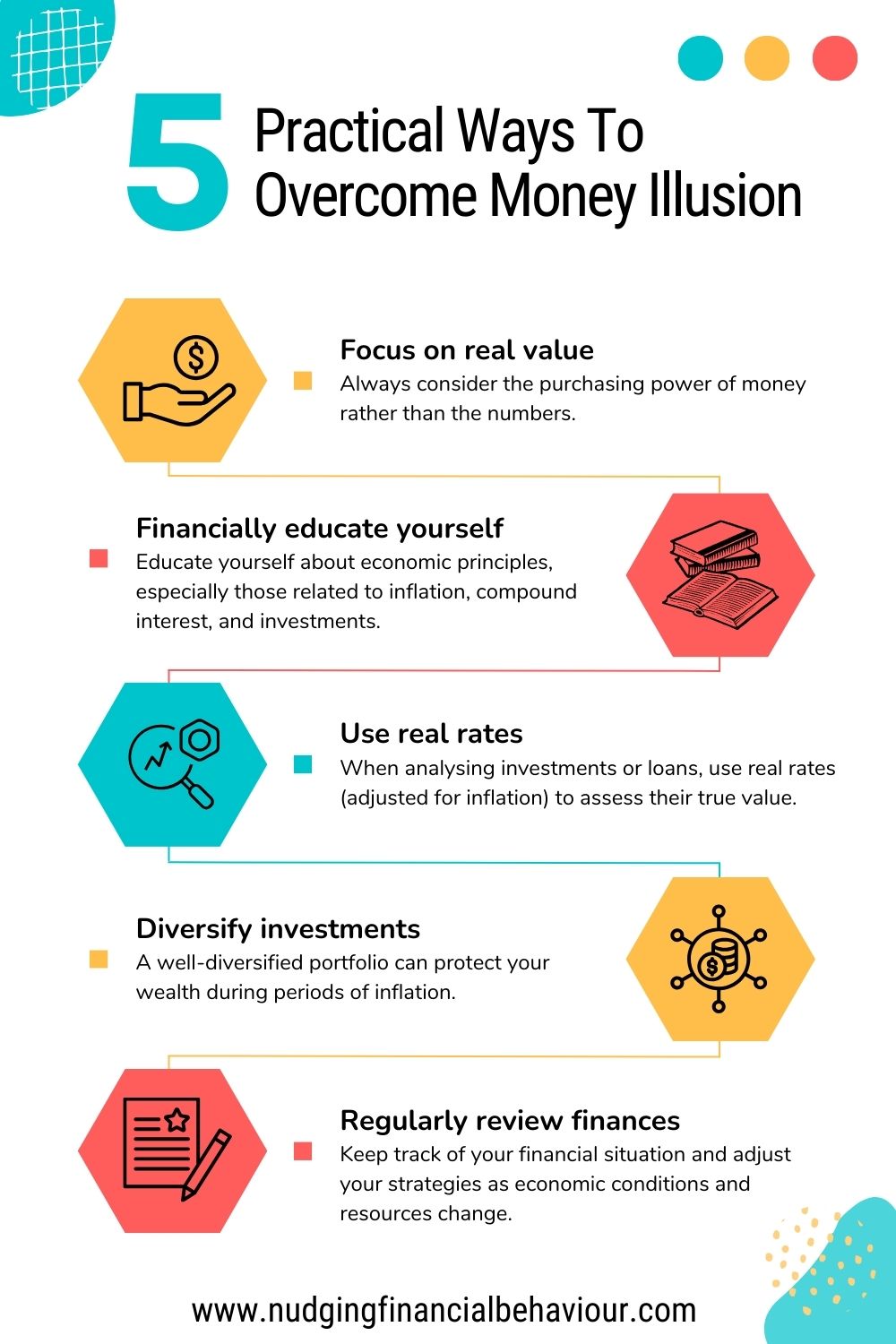Money, the universal medium of exchange, has an undeniable influence on our lives. From the moment we earn our first bit of pocket money, to our first salary, all the way to when we retire, financial decisions are part of our lives. However, our perception of money isn’t always as rational as we’d like to believe it is.
This post discusses a very sneaky cognitive bias known as money illusion. We share several money illusion examples so you’ll be very familiar with it by the end of this. And of course, we’ll end with some practical tips of how you can better equip yourself to not be fooled by this one.
In financial literacy research, there are 4 standard financial knowledge questions developed by Anamaria Lusardi and Olivia Mitchell, that groups of subjects are always asked in any study. Let me share one with you:
Suppose that in the year 2030, your income has doubled and prices of all goods have doubled too. In 2030, how much will you be able to buy with your income?
• More than today
• The same as today
• Less than today
• Do not know
It’s testing a basic financial knowledge concept known as exponential growth bias. Or as we like to call it: Money illusion.
Money illusion refers to our tendency to misinterpret changes in the nominal value of money without considering inflation. We focus on the amount of money in our hands, rather than it’s purchasing power.
In essence, money illusion is… illusory. This is why many think you can never go wrong with property.
Think about how much businesses paid for instant worldwide communication back in the day, compared to how cheap internet access is today. Money illusion causes us to focus on the amount of money rather than it’s worth.
Money illusion causes us to think about money in nominal terms rather than real ones. Share on X
John Maynard Keynes was the first to document that the average person views their wealth and income in nominal terms rather than real terms. Irving Fisher then further expanded upon this idea.
Imagine receiving a nominal wage increase of 5%. It sounds like a decent increase, but if inflation is at 6%, your purchasing power is actually decreasing. This is a classic example of money illusion – you’re being influenced by the nominal increase and nominal income and overlooking the real value of your real wages.
This explains why people put significant portions of their cash in low interest savings accounts, and why others get really excited about large multiple of value increases in housing prices without thinking through what it actually equates to in real terms.
Ultimately, higher periods of inflation are great for long term investors, as assets are discounted due to money illusion. Add the phillips curve and price stickiness to this and everything is impacted by money illusion – revenue, profits, asset prices, valuation ratios. This is one of the reasons why it’s difficult to compare the value of assets between decades – a price-earnings ratio in a decade of high or increasing inflation will be less real than one when inflation was low.
Price is what you pay. Value is what you get. Share on XHere’s another question for you. If I had to give you the choice between the following two options:
Which would you choose?
Option 2 is the better choice. Where option 1 gives you a total of $30 000 in 30 days, option 2 give you more than $5 million!
Our inability to see the growth potential with option 2 is because we’re accustomed to seeing things linearly, not exponentially. Once you start understanding exponential growth though, it’ll be clear why Albert Einstein said that “Compound interest is the 8th wonder of the world…”
Because we don’t think exponentially, information is often framed in such a way to either under – or – overplay our response to it. As an example, you could receive information as follows:
“The number of people who die in motor accidents increases by 14% every year.”
You’ll likely recognise that deaths on the road are increasing, but it’s unlikely you’ll comprehend the scale of that increase.
Alternatively, you could receive the same information, framed slightly differently, as follows:
“The number of people who die in motor accidents doubles ever 5 years.”
Now that shows the scale. (For those that want to check my maths – go ahead – the stats are identical.)
Similarly, if the growth in the rat population in your neighbourhood is going up at 10% every year, a journalist that wants to garner a response from the community will likely rather headline with “Rat population will double in 7 years!”
Consider an ancient Persian legend about some rice and a chessboard:
There was once a wise sage, who presented a King with a chessboard. The King was so impressed by the gift that he offered the sage any gift of his choosing. The sage responded ‘I want nothing more than to be paid in grains of rice’ and requested the king to put one grain of rice on the first square of the chessboard and then doubling it on every subsequent square. The king promptly agreed and asked for a bag of rice to be brought to the chessboard. Only when his servants began the task – placing a grain on the first square, two grains of rice on the second square, four grains of rice on the third, and so on – did her realise that he would need more rice than what was growing on earth!
To help our linear brains accurately grasp the scale of this exponential growth, I’ve done some calculations to show how much the sage would actually receive.
There are 64 squares on a chessboard. On the first row of the chessboard, which has 8 squares, the sage receives:
It’s not that promising to begin with. The growth is slow. But let’s persevere.
On the last square (#16) of the 2nd row, the sage would receive 32 768 grains of rice!
And this what the 3rd row would look like:
Quite a different story now.
On square 32 (we’re exactly half-way), the sage receives 34 359 738 368 grains of rice reaching a cumulative total of 68 719 476 735 grains.
Let me really blow your mind and start putting this in monetary terms. 1kg of rice equates to approximately 15 432 grains of rice. So, on square 32, the sage has 4 453 050 kg’s of rice. How much does rice cost? Well, I suppose the legend isn’t clear about the type of rice, so let’s just take an average price of R40 (or $2) per kg.
You ready?
That equates to R178 122 024 (or $9 433 974)!!
And we’re only halfway along the chessboard!
I know you’re curious about the final square (#64). The final square gets 18 446 744 073 709 551 615 grains of rice. The cumulative total now = too many numbers for me to type!
The results of this breakdown help us see that the growth is slow to begin with, but once it gets going, it really gets going. Similar to our investments. We might feel that we don’t have much to save, so we save nothing. But what we’re failing to see is that compounding works on even the smallest amounts.
A final consideration with exponential growth bias, is it’s similarity to pyramid schemes. Except with pyramid schemes, they eventually reach a point where they cannot double anymore.
Simplistically, you pay $1000 to invest in the business (substitute this ‘investment’ with anything you like, beauty products, forex, weight-loss formulas, anything). The principle is the same, all you need to do is recruit 4 new people who will each pay you $1000. Those 4 new recruits then recruit 4 more people, and on it goes.
It’s a very attractive business venture because it looks like you’re guaranteed a large profit. But, these schemes are illegal for good reason – they don’t work. Given the exponential growth required you’ll soon be unable to recruit enough people at the next level, which will leave everyone at the previous level with no money coming in.
Don’t fall for scams!

Money illusion impacts our savings and investment choices. Because we perceive money to have more value than it does (due to inflation), we underestimate the amount we need for retirement and other long-term goals. So, we don’t save or invest enough to secure our financial future.
Similarly, money illusion impacts our debt management decisions. When interest rates are low, we may be enticed to take on more debt, as the nominal interest rates seem attractive (recall our conversation with Wynand about being anchored to interest rates). If inflation is high, the real cost of servicing that debt might be significantly higher than we might have anticipated. When dealing with debt collectors, money illusion can have serious repercussions. Not understanding the true cost of your debt can lead to increased anxiety and an inability to meet outstanding obligations properly. Debt collectors such as Jefferson Capital Systems reviews can be a reminder of our financial challenges and add additional stress and emotional burden. Therefore, it’s imperative that we understand the true cost of our debts to avoid falling prey to money illusion.
Once you’ve familiarised yourself with the power of exponential growth, you’ll hopefully understand why many people create such a noise about having an awareness of the fees you pay on your investments. They’re usually disclosed in percentages, and the numbers are tiny. Perhaps your financial advisor charges a fee of only 2.5%. That doesn’t sound like a lot at all. When you start investing and you have $1000, that’s only $25. But consider how that $1000 is going to grow? Especially if you continue making contributions. It happens slowly, so you hardly see it, but eventually, that 2.5% is a large fee in your financial plan!

We must also apply this same thinking to inflation. If inflation is at 7%, that means the value of your $1 will be half that in 10 years. This can be quite a shattering realisation for anyone whose investments are not earning above inflationary returns.
When it comes to growth rates, don’t go with your intuition. Use a calculator.
When you get that option to pay the full years school fees upfront at a ‘discounted rate’ rather than monthly, do the maths. Use a calculator.
When you don’t want to put through a claim with Outsurance because you don’t want to lose your Outbonus, do the maths. Use a calculator.
To end, here are some useful strategies to help you navigate financial decisions with a clearer perspective:
Focus on real value: Always consider the purchasing power of your money rather than just the numbers. Factor in inflation when evaluating financial decisions and financial planning.
Financial education: Educate yourself about economic principles, especially those related to inflation, compound interest, and investment. Understanding these concepts will help you make informed decisions. For bonus points, understand how modified demand conditions arise and how prices respond differently in different market conditions. This will help you identify when you’re sitting with decreasing real wages.
Use real rates: When analysing investments or loans, use real interest rates (adjusted for inflation) to assess their true value. This is essential for wealth management.
Diversify investments: Diversification can help mitigate the impact of money illusion. A well-diversified portfolio can protect your wealth during periods of inflation.

Regularly review finances: Keep track of your financial situation and adjust your strategies as economic conditions and resources change. Regular reviews can help you adapt to inflationary periods.
Money illusion is a cognitive bias that can significantly impact our financial decision-making. By recognizing its presence in our lives and applying strategies to overcome it, we can make informed and prudent choices that align with our long-term financial goals. Remember, it’s not just about the numbers related to your money; it’s about the real value it holds in your life.
Let us know in the comments below.
I am passionate about helping people understand their behaviour with money and gently nudging them to spend less and save more. I have several academic journal publications on investor behaviour, financial literacy and personal finance, and perfectly understand the biases that influence how we manage our money. This blog is where I break down those ideas and share my thinking. I’ll try to cover relevant topics that my readers bring to my attention. Please read, share, and comment. That’s how we spread knowledge and help both ourselves and others to become in control of our financial situations.

Dr Gizelle Willows
PhD and NRF-rating in Behavioural Finance
Receive gentle nudges from us:
[user_registration_form id=”8641″]
“Essentially, all models are wrong, but some are useful.” – George E.P. Box
